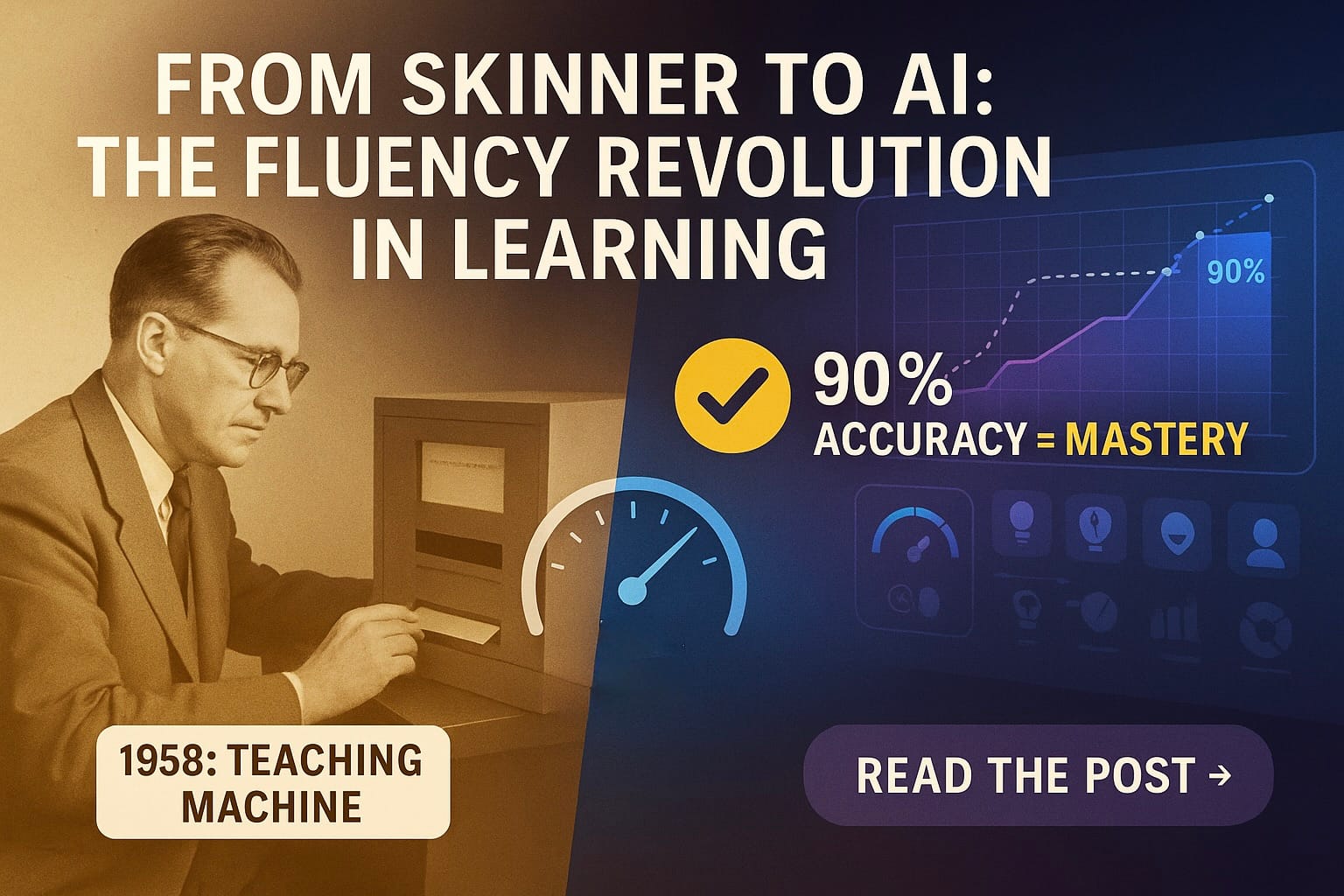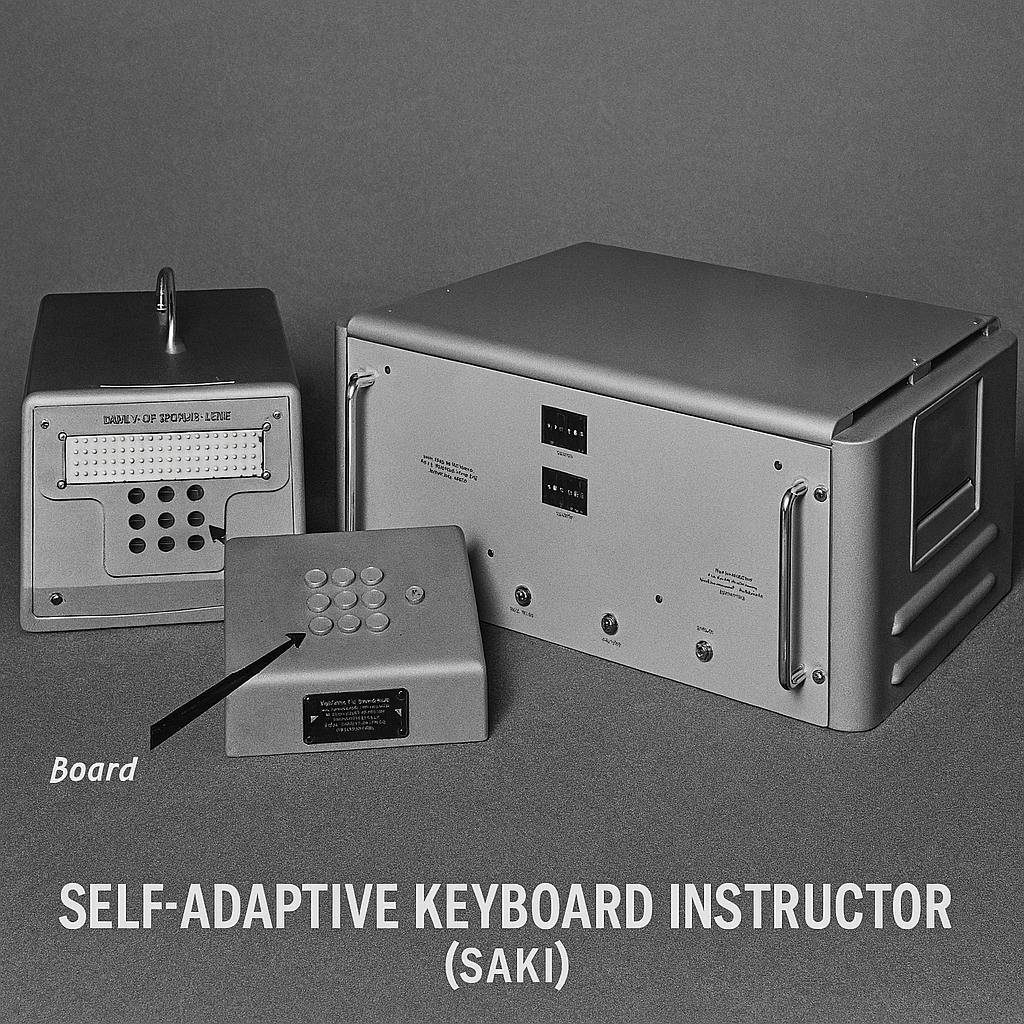From Teaching Machines to Smart Learning: The Science Behind Adaptive Education

How 70-year-old insights from B.F. Skinner's revolutionary teaching machines—combined with modern Precision Teaching research—are powering today's most effective learning technologies
The Revolutionary Moment That Changed Learning Forever
Picture this: It's 1958, and a Harvard psychologist named B.F. Skinner has just introduced something that seems like science fiction—a machine that teaches. Not just any machine, but one that adapts to each student's pace, provides instant feedback, and ensures mastery before moving forward.
While his contemporaries were still debating traditional teaching methods, Skinner was quietly engineering the future of personalized education. His "teaching machines" weren't just mechanical curiosities—they were the first glimpse into what we now recognize as adaptive learning technology.
But here's what Skinner couldn't have predicted: modern research would prove his intuitions about mastery were actually too conservative.
The Shocking Truth About What "Mastery" Really Means
For decades, educators have accepted 70-80% accuracy as "good enough" to move forward. This comfortable assumption has been shattered by rigorous behavioral research.
The evidence is stark and unforgiving:
Fuller & Fienup (2018) taught individuals new skills to different mastery criteria—50%, 80%, or 90% correct—then measured retention weeks later. The results were stunning: only the skills mastered at 90% were consistently maintained over time. Those learned to 50% or 80%? Largely forgotten.
Richling et al. (2019) went further, systematically comparing criteria from 60% all the way to 100%. Their finding revolutionizes how we think about learning: performance maintained best under the highest criteria, especially 90-100% correct.
This isn't just academic theory—it's the difference between knowledge that fades and skills that last a lifetime.
Beyond Accuracy: The Precision Teaching Revolution
But even 90% accuracy tells only part of the story. Enter Precision Teaching—a methodology that revolutionized our understanding of true mastery by recognizing a critical insight: fluency isn't just about being right, it's about being right quickly, consistently, and durably.
Precision Teaching measures what behavioral scientists call REAPS outcomes:
- Retention - Can you remember it weeks later?
- Endurance - Can you maintain performance over extended periods?
- Application - Can you generalize the skill to new situations?
- Performance Stability - Does your skill hold up under pressure or distraction?
Traditional education stops at accuracy. Precision Teaching demands all four.
The Hidden Science Behind Why Some People Learn Faster
What Skinner discovered through meticulous behavioral research was revolutionary: learning isn't one-size-fits-all, and neither should instruction be. But modern Precision Teaching research has revealed something even more profound.
True fluency requires hitting specific rate targets—not just getting answers right, but getting them right at functionally useful speeds:
- Reading fluency: 150-200 words per minute
- Math facts: 70-90 correct digits per minute
- Language skills: Specific rates based on real-world application needs
Why does speed matter? Because when basic skills become automatic—when you don't have to think about them—your cognitive resources are freed up for higher-order thinking and complex problem-solving.
The Forgotten Pioneers Who Cracked the Code
While Skinner focused on linear progression, Norman Crowder was developing something even more sophisticated—branching programs that could diagnose specific mistakes and provide targeted remediation.
Meanwhile, Gordon Pask was building the world's first truly adaptive teaching machine. His Self-Adaptive Keyboard Instructor (SAKI) didn't just follow pre-programmed sequences—it built a real-time model of each learner's strengths and weaknesses, adjusting difficulty moment by moment.

"The difficulty of the questions are not pre-programmed," Pask explained. "The machine builds a profile of what the individual learner finds easy or hard, and adapts accordingly."
What's remarkable is how closely Pask's 1956 machine anticipated modern Precision Teaching principles—both recognized that effective learning systems must continuously monitor performance and adjust in real-time.
The 85% Rule Meets the 90% Reality
Recent research has uncovered the "85% Rule"—learners achieve maximum growth when they're succeeding about 85% of the time during practice. This seems to contradict the 90%+ mastery research, but here's the key distinction:
- 85% success during learning keeps you in the optimal challenge zone for skill acquisition
- 90%+ accuracy before progression ensures the skill is truly mastered and won't be forgotten
The most sophisticated learning systems use both principles: they maintain 85% success rates during practice to maximize engagement and growth, then require 90%+ fluency demonstrations before allowing advancement to new material.
Why Traditional Education Gets It Catastrophically Wrong
Here's the uncomfortable truth: most traditional education operates on a factory model that fundamentally misunderstands how learning works.
The Traditional Model:
- Move everyone through material at the same pace
- Accept 70-80% as "passing"
- Focus on coverage over mastery
- Measure only accuracy, ignore speed and retention
The Result: Students advance with significant knowledge gaps, skills deteriorate rapidly, and learning becomes increasingly difficult as weak foundations crumble.
The Mastery Teaching Model:
- Individualized pacing based on fluency achievement
- Require 90%+ accuracy plus speed benchmarks
- Focus on mastery over coverage
- Measure retention, endurance, application, and stability
The Result: Unshakeable skill foundations that support accelerated learning and lifelong retention.
The Modern Revolution: AI Meets Behavioral Science
The parallels between Skinner's teaching machines and today's AI-powered learning platforms reveal remarkable continuity in educational technology principles.
Individualized Learning Pace Both systems prioritize allowing learners to progress through material at their own speed rather than being constrained by traditional classroom timing. Teaching machines let students move forward when ready, while modern AI tools like Khan Academy and Duolingo adapt in real-time to each learner's needs.
Instant Feedback Systems Where teaching machines once provided immediate right-or-wrong responses to help students correct mistakes on the spot, today's AI tools offer enhanced real-time feedback with explanations, visuals, and hints tailored to specific error patterns.
Mastery Before Moving Forward The concept of mastery-based progression remains central to both approaches. Teaching machines required students to demonstrate competency before advancing to new material. Contemporary AI systems use sophisticated algorithms that ensure sufficient understanding before allowing students to move forward.
Data-Driven Personalization Both rely on measuring student behavior and performance, though with vastly different capabilities. Teaching machines offered limited branching based on responses, while AI tools now leverage vast datasets and machine learning to create nuanced recommendations and predict future learning needs.
Repetition and Practice The emphasis on repetition remains constant across both eras. Teaching machines provided systematic exposure to concepts with variation until students achieved fluency. Today's platforms use spaced repetition algorithms and adaptive quizzes found in applications like Behavior Study Tools test preparation.
Outcome Tracking Modern AI systems have evolved beyond simple correct-answer tracking to implement comprehensive outcome monitoring that ensures skills are retained, endure over time, apply to new contexts, and remain stable across different situations. While teaching machines could only verify immediate accuracy, today's AI platforms use longitudinal data tracking to monitor whether students can recall information weeks later, transfer knowledge to novel problems, and maintain performance consistency. This framework represents a significant advancement in educational measurement, moving from behavioral observation to deep learning assessment.
But here's what sets the best systems apart: they don't just track whether you got the answer right—they measure whether you've achieved a level of mastery that will that will last.
Your Learning Potential Is Bigger Than You Think
The implications are revolutionary. When learning systems combine adaptive technology with fluency standards:
- Knowledge gaps that seemed permanent disappear as solid foundations are built
- Learning acceleration increases dramatically as basic skills become automatic
- Confidence soars as learners experience true mastery rather than superficial coverage
- Skills transfer broadly because fluent foundations support complex applications
This isn't about working harder—it's about working with precision, ensuring every minute of practice builds toward lasting mastery.
The Fluency Advantage: Speed + Accuracy over time = Transformation
Consider two students learning multiplication facts:
Student A (Traditional): Achieves 80% accuracy, moves to division. Struggles with division because multiplication isn't fluent. Falls further behind as cognitive load increases.
Student B (Mastery Teaching): Achieves 90% accuracy at 70+ digits per minute before advancing. Division becomes easy because multiplication is automatic. Accelerates into advanced mathematics.
The difference isn't intelligence—it's methodology. Mastery-based learning creates upward spirals of success.
Ready to Experience True Mastery?
The principles that Skinner pioneered and Precision Teaching perfected aren't just academic theories—they're practical tools that can transform how you learn anything.
Whether you're mastering a new skill, changing habits, or pursuing professional development, learning systems built on fluency principles can help you achieve not just temporary success, but lasting mastery.
Try Behavior Study Tools and experience firsthand how precision-based, adaptive learning can unlock your true potential. Built on decades of behavioral research and powered by fluency-tracking algorithms, it's designed to ensure you don't just learn—you master skills that last.
Because your goals deserve more than superficial success. They deserve true fluency. They deserve the unshakeable confidence that comes from knowing your skills will be there when you need them, performing automatically and reliably under any conditions.
The Choice Is Clear:
| Traditional Learning | Precision-Based Mastery |
|---|---|
| 70-80% accuracy = "good enough" | 90%+ accuracy + speed = true mastery |
| Skills fade quickly | Skills retained long-term |
| Struggles compound over time | Success accelerates over time |
| Coverage over mastery | Fluency over completion |
Stop settling for learning that fades. Start building skills that last a lifetime.
Ready to stop settling for generic learning experiences? Discover how adaptive, behavior-based tools can accelerate your progress at study.behaviorschool.com.
 by Rob Spain
by Rob Spain